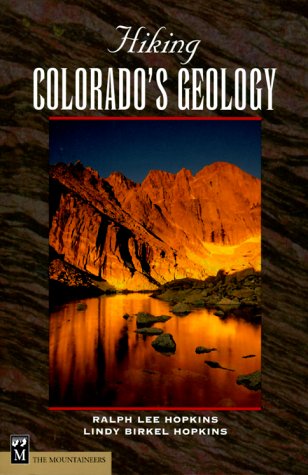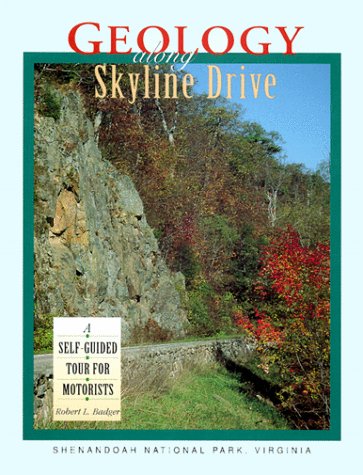
Vince Matthews

Book reviews:
 |
Hiking Colorado's
Geology by Ralph Lee Hopkins and Lindy Birkel Hopkins, Mountaineers
Books (2000). 256 p. ISBN 0-898-86708-8. Illus. $16.95. (Phone: 800-553-4453)
Vince Matthews |
“These mountains of fire were ultimately chilled in the Ice Age freezer that worked its magic on their peaks during the past 1.8 million years, carving mountaintops and valleys into the dramatic shapes of today's San Juan Mountains." Such is the kind of delightful writing found in Hiking Colorado's Geology, by Ralph and Lindy Hopkins. The Hopkinses have created a book that is much more than a guide to interesting geological locales. Indeed, it is worth reading for the geology even if one never attempts any of the 50 trails it describes.
The text is nicely written, succinct and well researched. One is hard-pressed to find geological descriptions or interpretations in it with which to quibble. Ralph's beautiful photographs artistically illustrate the geologic features. The graphics are excellent — uncluttered, pertinent and useful.
The hikes cover a broad cross section of Colorado's geology and geography, from the prairie of eastern Colorado, through the mountains, and to the plateau of western Colorado. The trails lead to such diverse features as glaciers, fossils, granite batholiths, volcanic breccia, metamorphic rocks, landslides, sand dunes, volcanic ash and flows, hot springs, a "fourteener," mining districts, arches, dikes, dinosaur footprints, faults, unconformities and much more.
The Introduction offers a general summary of geologic principles for the non-geologist. Topics include Colorado's landscapes, major rock types, sedimentary structures, geologic structures, plate tectonics, topographic and geologic maps and tips on hiking Colorado's mountains.
The hikes are grouped into 11 geologic areas, with a précis on the geology of each area and specific descriptions of the geology to be seen along each hike. The authors have also supplied distance, elevation, difficulty, topographic maps, geologic maps, key references, precautions, and contacts for each hike. The text for the individual hikes begins with a short summary of the principal attractions entitled, "About the Landscape." The "Trail Guide" begins with an excellent description of how to reach the trailhead from the nearest population center.
I enjoyed reading the book and recommend it for anyone interested in the geology of Colorado. For those interested in hitting the trails in search of interesting geologic features, this book is a "must." I can't wait for the snow to melt so I can experience some of these trails firsthand.
Matthews is Senior Science Advisor for the Colorado Geological Survey.
 |
Geology along Skyline
Drive: Shenandoah National Park, Virginia by Robert L. Badger. Falcon
Publishing Inc. 1999. 100 p. ISBN 1-56044-691-9. Illus. Softcover,
$10.95. (Phone: 406-442-6597)
Frederick L. Schwab |
This attractively illustrated volume, subtitled, "A Self-Guided Tour for Motorists," is a nice introduction to the geology of the Blue Ridge Province in Virginia, and is suitable for amateurs and professionals alike. The author, while working on his field geology thesis at nearby Virginia Tech, obviously became enchanted with the geology along Skyline Drive, the tranquil scenic highway that follows the crest of the Blue Ridge Mountains for 105 miles from Front Royal, Va. (80 miles west of Washington, D.C.) to Rockfish Gap near Charlottesville, Va. (at which point it joins the Blue Ridge Parkway, which continues southwest to the Great Smokey Mountains almost 500 miles away).
The "highway," a beautifully landscaped, winding, two-lane parkway with a strictly enforced 45 mph speed limit, was constructed as a Bureau of Public Roads project in the early 1930s during the Depression. It meanders along the ridgeline of the Blue Ridge, arguably the most fascinating province of what many geologists agree is the world's most elegant mountain system. Skyline Drive offers countless spectacular views not only of the Blue Ridge, but also of the adjacent Valley and Ridge and Piedmont provinces that lie immediately to the northwest and southeast.
Roughly 75 scenic overlooks and trailhead parking areas occur along the length of the parkway. From these, Badger selects the 23 that are easily accessible and geologically most interesting. The bulk of the book is a series of two-to-three-page guides to the geology on display at each stop.
The book begins with a handy index map of the boundaries of Shenandoah National Park, the route of Skyline Drive and the location of each stop. An introductory chapter introduces elementary rock classification and outlines the geology of the Blue Ridge Mountains. The descriptions include just enough petrology to enlighten without boring the reader, and it pay nodding attention to the salient aspects of rock age and geological structure. A nice, although perhaps oversimplified for specialists, thumbnail sketch of plate tectonics theory precedes a four-page review of the geological origin and evolution of the Virginia Appalachians.
Three-fourths of the book is well organized, nicely illustrated descriptions of each stop. Stops are identified by name, specific mileage post number, and by accurate mileage measurements from both the northbound and southbound Skyline Drive entrances. Descriptions guide the reader with some precision to what is to be seen at each stop. Nicely produced color photographs, sharply focused, beautifully colored, even "artistic," typically show the overall exposure described, specific details that are discussed in the text, as well as the distant vistas that can be seen from each location. A trained geologist will have no trouble finding what the author discusses. Amateur rock hounds may shuffle about a bit before finding the more detailed features the guide identifies.
To his credit, Badger with some consistency successfully places the details of individual features at each stop in the context of the overall Appalachian System. I've been running up and down Skyline Drive and the Blue Ridge Parkway for decades, sometimes with field classes, sometimes on a bike, and yet I'm eager to investigate for myself several of the localities Badger has conveniently identified for me.
The book should be on the "buy" list of anyone coming to see the geology of the Blue Ridge, whether on their own for a pleasure trip, with a group of students from elsewhere in the Appalachians, from the far corners of the American West, or from elsewhere around the globe.
Hard-rock geologists, as well as stratigraphers and geomorphologists, will find the text weighted a bit in their favor, but that's the nature of the Blue Ridge itself. The hand, easy-to-use guide is a welcome addition. If you're coming to Blue Ridge and driving Skyline Drive, don't leave home without this book.
Schwab teaches in the Department of Geology at Washington and Lee University in Lexington, Va.
Ionospheres: Physics, Plasma Physics, and Chemistry, by Robert W. Schunk and Andrew F. Nagy. Cambridge University Press (2000). 554 p. ISBN 0-521-63237-4. Illus. Cloth, $100. (Phone: 800-872-7423)
Isolated Shallow Marine Sand Bodies: Sequence Stratigraphic Analysis and Sedimentologic Interpretation, edited by Katherine M. Bergman and John W. Snedden. SEPM Special Publication #64 (1999). 362 p. ISBN 1-56579-057-3. Illus. Cloth, $120. (Phone: 800-865-9765)
Landslides and Tsunamis, edited by Barbara H. Keating, Christopher F. Waythomas and Alastair G. Dawson. Birkhauser Verlag (2000). 1313 p. ISBN 3-7643-6300-2. Illus. Paperback, $59.95. (Phone: 617-876-2333)
Methodological and Technological Issues in Technology Transfer, edited by Bert Metz, Ogunlade R. Davidson, Jan-Willem Martens, Sasca N.M. van Rooijen and Laura Van Wie McGrory. Cambridge University Press (2000). 466 p. ISBN 0-521-80494-9. Illus. Paperback, $35.95. (Phone: 800-872-7423)
Microbial Sediments, edited by Robert E. Riding and Stanley M. Awramik. Springer (2000). 331 p. ISBN 3-540-61828-7. Illus. Cloth, $206. (Phone: +49 6221 487 0)
Norumbega Fault System of the Northern Appalachians, edited by Allan Ludman and David P. West Jr. Geological Society of America (1999). Special Paper 331. 202 p. ISBN 0-8137-2331-0. Illus. Paperback, $55. (Phone: 800-472-1988)
Numerical Simulation of Reactive Flow by Elaine S. Oran and Jay P. Boris. Cambridge University Press (2000). 529 p. ISBN 0-521-58175-3. Illus. Cloth, $90. (Phone: 800-872-7423)
Numerical Models in Groundwater Pollution by Karel Kovarik. Springer (2000). 221 p. ISBN 3-540-66792-X. Illus. Cloth, $79.95. (Phone: 800-472-1988)
The Paleontological Research Institute in Ithaca, N.Y., houses one of the Northeast's largest invertebrate fossil collections. Its Web site highlights these ancient organisms, as well as the Institute's plans to exhibit such specimens in a state-of-the-art Museum of Earth adjacent to PRI's current location. The site is an easy-to-use hub of information on PRI's fossils, acquisition of a Northern right whale skeleton, field trips, Museum of Earth plans and educational sites. Points of interest include the Glacial Legacies download and an image database of invertebrate fossils cleverly laid out in clickable "drawers" found by following the "Collections" link. Glacial Legacies chronicles the glacial history of New York in 59 text and image slides, detailing topics such as kettle lakes, erratics and gravel pits. "Touring the Collections" gives you access to limited, but well-described arthropod and echinoderm fossil images. Another feature is the Mastodon Project page, which chronicles PRI's excavation and study of the Gilbert and Hyde Park mastodons. These pages include pictures of unearthed mastodon tusks and bones, their assembled skeletons, and clips of media coverage of the events.
www.pbs.org/wgbh/aso/tryit/tectonics/intro.html
Want an interactive way to teach your students (or yourself) about plate tectonics? Check out this PBS site offering an animated Shockwave image that lets you virtually create sea-floor spreading, a transform fault, and subduction and convergent zones, all with a move of your mouse. A map below the image indicates where in the world these processes occur today, and accompanying text describes the massive crustal deformation you just made. By following the hyperlinks throughout the site, learn about the history of plate tectonics ranging from Alfred Wegener's continental drift theory to the discovery of the Mid-Ocean Ridge. If you are still hungry for interactive fun, click on the "You Try It Menu" to play with any one of the site's seven other activities.
Jann Vendetti
 |
Geotimes Home | AGI Home | Information Services | Geoscience Education | Public Policy | Programs | Publications | Careers |